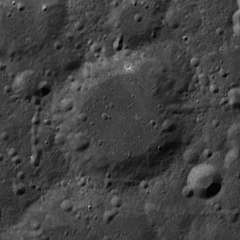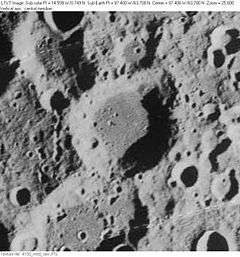Boole (crater)
Boole is a lunar impact crater that lies along the northwestern limb of the Moon, to the northwest of the crater Gerard. At this location it is viewed nearly from the side, and is very oblong in shape due to foreshortening. The crater formation is nearly circular, however, with a wide inner wall that has been worn and rounded due to subsequent impacts. It is named after George Boole.
 LRO mosaic | |
| Coordinates | 63.7°N 87.4°W |
|---|---|
| Diameter | 63 km |
| Depth | Unknown |
| Colongitude | 89° at sunrise |
| Eponym | George Boole |

To the north of Boole is the crater Cremona, and to the southwest are Paneth and Smoluchowski. The eroded and somewhat distorted satellite crater Boole E is attached to the southern rim, forming a saddle-shaped valley between the two formations. The interior floor of Boole is relatively flat, and marked only by tiny craterlets. There is a small craterlet on the floor next to the southwest rim, and a tiny crater along the western inner wall.
The surface along the western face of Boole is pock-marked by a multitude of small craterlets that run in a northerly direction towards Brianchon. A sequence of these impacts forms a short catena, or crater chain, near the western rim of Boole.
Satellite craters
By convention these features are identified on lunar maps by placing the letter on the side of the crater midpoint that is closest to Boole.
| Boole | Latitude | Longitude | Diameter |
|---|---|---|---|
| A | 63.6° N | 80.6° W | 56 km |
| B | 63.6° N | 77.3° W | 9 km |
| C | 65.4° N | 82.5° W | 18 km |
| D | 64.0° N | 83.5° W | 10 km |
| E | 62.9° N | 84.6° W | 16 km |
| F | 64.2° N | 79.4° W | 34 km |
| G | 64.8° N | 90.9° W | 41 km |
| H | 61.6° N | 88.9° W | 75 km |
| R | 64.4° N | 78.0° W | 13 km |
References
- Andersson, L. E.; Whitaker, E. A. (1982). NASA Catalogue of Lunar Nomenclature. NASA RP-1097.CS1 maint: ref=harv (link)
- Blue, Jennifer (July 25, 2007). "Gazetteer of Planetary Nomenclature". USGS. Retrieved 2007-08-05.CS1 maint: ref=harv (link)
- Bussey, B.; Spudis, P. (2004). The Clementine Atlas of the Moon. New York: Cambridge University Press. ISBN 978-0-521-81528-4.CS1 maint: ref=harv (link)
- Cocks, Elijah E.; Cocks, Josiah C. (1995). Who's Who on the Moon: A Biographical Dictionary of Lunar Nomenclature. Tudor Publishers. ISBN 978-0-936389-27-1.CS1 maint: ref=harv (link)
- McDowell, Jonathan (July 15, 2007). "Lunar Nomenclature". Jonathan's Space Report. Retrieved 2007-10-24.CS1 maint: ref=harv (link)
- Menzel, D. H.; Minnaert, M.; Levin, B.; Dollfus, A.; Bell, B. (1971). "Report on Lunar Nomenclature by the Working Group of Commission 17 of the IAU". Space Science Reviews. 12 (2): 136–186. Bibcode:1971SSRv...12..136M. doi:10.1007/BF00171763.CS1 maint: ref=harv (link)
- Moore, Patrick (2001). On the Moon. Sterling Publishing Co. ISBN 978-0-304-35469-6.CS1 maint: ref=harv (link)
- Price, Fred W. (1988). The Moon Observer's Handbook. Cambridge University Press. ISBN 978-0-521-33500-3.CS1 maint: ref=harv (link)
- Rükl, Antonín (1990). Atlas of the Moon. Kalmbach Books. ISBN 978-0-913135-17-4.CS1 maint: ref=harv (link)
- Webb, Rev. T. W. (1962). Celestial Objects for Common Telescopes (6th revised ed.). Dover. ISBN 978-0-486-20917-3.CS1 maint: ref=harv (link)
- Whitaker, Ewen A. (1999). Mapping and Naming the Moon. Cambridge University Press. ISBN 978-0-521-62248-6.CS1 maint: ref=harv (link)
- Wlasuk, Peter T. (2000). Observing the Moon. Springer. ISBN 978-1-85233-193-1.CS1 maint: ref=harv (link)
